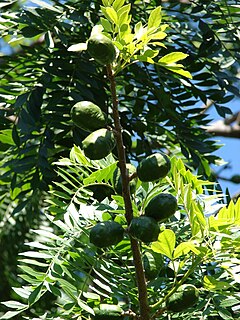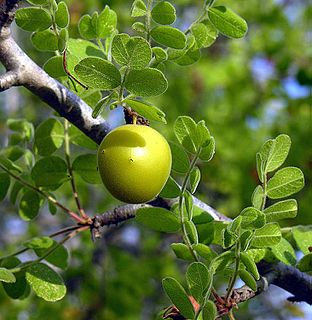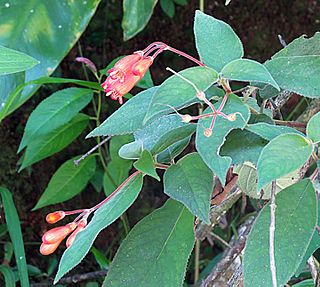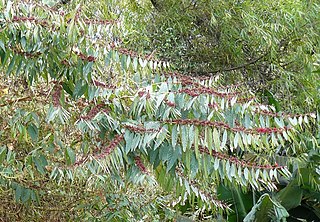
The Anacardiaceae, commonly known as the cashew family or sumac family, are a family of flowering plants, including about 83 genera with about 860 known species. Members of the Anacardiaceae bear fruits that are drupes and in some cases produce urushiol, an irritant. The Anacardiaceae include numerous genera, several of which are economically important, notably cashew, mango, Chinese lacquer tree, yellow mombin, Peruvian pepper, poison ivy, poison oak, sumac, smoke tree, marula and cuachalalate. The genus Pistacia is now included, but was previously placed in its own family, the Pistaciaceae.

Kai Larsen was a Danish botanist.

Spondias is a genus of flowering plants in the cashew family, Anacardiaceae. The genus consists of 17 described species, 7 of which are native to the Neotropics and about 10 are native to tropical Asia. They are commonly named hog plums, Spanish plums, libas in Bikol, Isbadhes in Somalia and in some cases golden apples for their brightly colored fruit which resemble an apple or small plum at a casual glance. They are only distantly related to apple and plum trees, however. A more unequivocal common name is mombins.

Astronium is a genus of flowering plants in the cashew family, Anacardiaceae. It is native to Central and South America.

Afrofittonia commonly known as the hunter's weed, is a genus of plants in the family Acanthaceae. There is only one species in the genus, Afrofittonia silvestris. It is found in Cameroon, Equatorial Guinea, and Nigeria. Its natural habitat is subtropical or tropical moist lowland forests. It is threatened by habitat loss due to Oil & gas drilling.

Poupartia is a genus of plant in family Anacardiaceae. From the islands of Madagascar, Mauritius, Rodrigues and Réunion, all in the Indian Ocean.

Semecarpus australiensis, commonly known as the tar tree, native cashew, marking nut, or cedar plum, is a species of tree in the cashew, sumac and mango family Anacardiaceae, native to parts of Melanesia and northern Australia. Contact with the plant can cause serious allergic reactions, a common characteristic of this family.

Cyrtocarpa is a genus of trees in the subfamily Spondiadoideae of the cashew and sumac family Anacardiaceae. Their habitat is dry forests to open arid areas. They grow naturally in Mexico and northern South America.

Whitfordiodendron is a genus of flowering plants in the legume family, of Fabaceae. It belongs to the subfamily Faboideae.
Turgeniopsis is a monotypic genus of flowering plants belonging to the family Apiaceae. It only contains one known species, Turgeniopsis foeniculacea(Fenzl) Boiss.
Koordersiodendron is a monotypic genus of flowering plants belonging to the family Anacardiaceae. It only contains one known species, Koordersiodendron pinnatum(Blanco) Merr.
Lelya is a monotypic genus of flowering plants belonging to the family Rubiaceae. It only contains one known species, Lelya osteocarpaBremek.

Nayariophyton is a monotypic genus of flowering plants belonging to the family Malvaceae. It only contains one known species, Nayariophyton zizyphifolium(Griff.) D.G.Long & A.G.Mill.
Merrilliodendron is a monotypic genus of flowering plants belonging to the family Icacinaceae. It has a synonym of PeekeliodendronSleumer. The only species is Merrilliodendron megacarpum(Hemsl.) Sleumer
Nectouxia is a monotypic genus of flowering plants belonging to the family Solanaceae. The only species is Nectouxia formosa. It is in the Solanoideae subfamily and in Subtribe Salpichroinae, which is a subtribe of Physaleae.
Ochoterenaea is a monotypic genus of flowering plants belonging to the family Anacardiaceae. The only species is Ochoterenaea colombiana.
Dutailliopsis gordonii is a species of flowering plants in the monotypic genus of Dutailliopsis and belongs to the family Rutaceae.

Moussonia is a genus of plants in the family Gesneriaceae. Its native range stretches from Mexico to Central America. It is found in Costa Rica, El Salvador, Guatemala, Honduras, Mexico and Panamá.

Pehria is a monotypic genus of plant in family Lythraceae. It has one known synonym, GrisleaLoefl.. The genus just contains one known species, Pehria compacta(Rusby) Sprague

Pometia is a genus of 2 species of rainforest trees, constituting part of the plant family Sapindaceae.












